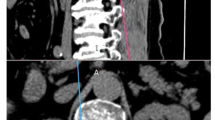Abstract
Objectives
Percutaneous vertebroplasty (PV) of the cervical spine has been traditionally performed with a trans-oral or antero-lateral approach. The posterior trans-pedicular approach (PTPA) has been sporadically reported. Therefore, the aim of this study is to retrospectively assess the technical feasibility, safety, and clinical outcomes of cervical PV performed with a PTPA.
Methods
All consecutive patients undergoing PV in cervical levels with PTPA (under general anesthesia and computed tomography [CT] guidance) from January 2008 to November 2019 were identified. The following data were collected: patients’ demographics; indication for PV; vertebral level features; procedure-related variables; and clinical outcomes including complications and pain relief.
Results
Thirty-two patients (18 females, 14 males; mean age 61.1 ± 13.2 years, range 36–88) were included accounting for 36 vertebrae. Three vertebrae (3/36, 8%) were referred due to an underlying traumatic fracture, the remaining (33/36, 92%) due to a painful lytic tumor. Technical success was 97% (35/36 levels). Mean time required to deploy the trocar was 23 ± 11 min (range 7–60). Extra-vertebral asymptomatic cement leakage was observed in 3/35 (9%) vertebral levels. One patient (1/32, 3%) developed an acute cardiogenic pulmonary edema requiring admission in the intensive care unit; another patient (1/32, 3%) developed localized infection to the skin entry site, which was managed conservatively. At 1-month follow-up, the mean pain in the study population was 1.0 ± 1.1 (range 0–4/10) vs 6.2 ± 1.4 (range 4–9/10) at baseline (p < 0.05).
Conclusions
Cervical PV performed via a CT-guided PTPA is technically feasible, safe, and results in effective pain relief.
Key Points
• Percutaneous vertebroplasty (PV) is a well-established technique for the treatment of benign and malignant compression fractures.
• Common PV approaches used for cervical vertebrae include the trans-oral, antero-lateral, lateral, and sporadically the posterior trans-pedicular approach.
• Retrospective analysis of our 11-year experience with the posterior trans-pedicular approach used for cervical vertebrae proved that such approach was safe and effective.



Similar content being viewed by others
Abbreviations
- ALA:
-
Antero-lateral approach
- BMI:
-
Body mass index
- DLP:
-
Dose length product
- IQRs:
-
Interquartile ranges
- LA:
-
Lateral approach
- PTPA:
-
Posterior trans-pedicular approach
- PV:
-
Percutaneous vertebroplasty
- TOA:
-
Trans-oral approach
References
Health Quality Ontario (2016) Vertebral augmentation involving vertebroplasty or kyphoplasty for cancer-related vertebral compression fractures: a systematic review. Ont Health Technol Assess Ser 16(11):1–202
Tsoumakidou G, Too CW, Koch G et al (2017) CIRSE guidelines on percutaneous vertebral augmentation. Cardiovasc Intervent Radiol 40(3):331–342
Anselmetti GC, Marcia S, Saba L et al (2012) Percutaneous vertebroplasty: multi-centric results from EVEREST experience in large cohort of patients. Eur J Radiol 81(12):4083–4086
Clarençon F, Fahed R, Cormier E et al (2020) Safety and effectiveness of cervical vertebroplasty: report of a large cohort and systematic review. Eur Radiol 30(3):1571–1583
Tong FC, Cloft HJ, Joseph GJ, Rodts GR, Dion JE (2000) Transoral approach to cervical vertebroplasty for multiple myeloma. AJR Am J Roentgenol 175(5):1322–1324
Guo WH, Meng MB, You X et al (2012) CT-guided percutaneous vertebroplasty of the upper cervical spine via a translateral approach. Pain Physician 15(5):E733–E741
Sun HY, Lee JW, Kim KJ, Yeom JS, Kang HS (2009) Percutaneous intervention of the C2 vertebral body using a CT-guided posterolateral approach. AJR Am J Roentgenol 193(6):1703–1705
Cianfoni A, Distefano D, Chin SH, Varma AK, Rumboldt Z, Bonaldi G (2012) Percutaneous cement augmentation of a lytic lesion of C1 via posterolateral approach under CT guidance. Spine J 12(6):500–506
Filippiadis DK, Binkert C, Pellerin O, Hoffmann RT, Krajina A, Pereira PL (2017) Cirse quality assurance document and standards for classification of complications: the CIRSE classification system. Cardiovasc Intervent Radiol 40(8):1141–1146
De la Garza-Ramos R, Benvenutti-Regato M, Caro-Osorio E (2016) Vertebroplasty and kyphoplasty for cervical spine metastases: a systematic review and meta-analysis. Int J Spine Surg 10:7
Bousson V, Guinebert S, Odri G et al (2020) Curved discography needle for percutaneous cervical spine vertebroplasty: a technical note. J Vasc Interv Radiol 31(4):686–689
Funding
The authors state that this work has not received any funding.
Author information
Authors and Affiliations
Corresponding author
Ethics declarations
Guarantor
The scientific guarantor of this publication is Pr Afshin Gangi.
Conflict of interest
The authors of this manuscript declare no relationships with any companies whose products or services may be related to the subject matter of the article.
Statistics and biometry
One of the authors has significant statistical expertise.
Informed consent
Written informed consent was waived by the Institutional Review Board.
Ethical approval
Institutional Review Board approval was obtained.
Methodology
• retrospective
• observational
• performed at one institution
Additional information
Publisher’s note
Springer Nature remains neutral with regard to jurisdictional claims in published maps and institutional affiliations.
Rights and permissions
About this article
Cite this article
Cazzato, R.L., de Marini, P., Auloge, P. et al. Percutaneous vertebroplasty of the cervical spine performed via a posterior trans-pedicular approach. Eur Radiol 31, 591–598 (2021). https://doi.org/10.1007/s00330-020-07198-6
Received:
Accepted:
Published:
Issue Date:
DOI: https://doi.org/10.1007/s00330-020-07198-6




